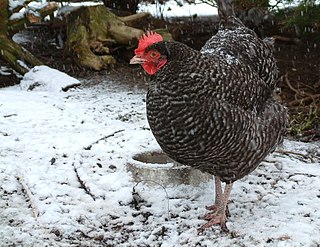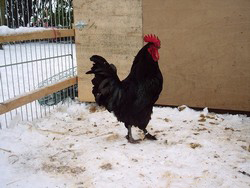
The La Flèche, French: Poule de La Flèche, is a rare French breed of dual-purpose domestic chicken. It originates from the département of the Sarthe, in the Pays de la Loire region, and is named for the town and commune of La Flèche in that area, not far from the capital of the Sarthe, Le Mans. The breed was once famous for the fine quality of its meat; since the Second World War, numbers have fallen very low.

The Marans, French: Poule de Marans, is a French breed of dual-purpose chicken, reared both for meat and for its dark brown eggs. It originated in or near the port town of Marans, in the département of Charente-Maritime, in the Nouvelle-Aquitaine region of south-western France.
The Blue Foot or Poulet Bleu is a Canadian chicken hybrid bred to resemble the French Poulet de Bresse.

The poulet de Bresse or volaille de Bresse is a French chicken product which has appellation d'origine contrôlée status, and which was registered as a Protected Designation of Origin under EU and UK law as Volaille de Bresse / Poulet de Bresse / Poularde de Bresse / Chapon de Bresse. It may be produced only from white chickens of the Bresse Gauloise breed raised within a legally-defined area of the historic region and former province of Bresse, in eastern France.

The Barbu d'Anvers, Dutch: Antwerpse baardkriel, is a breed of bantam chicken from Belgium. It is a true bantam, and has no full-sized counterpart; males weigh about 700 grams and hens about 600 g. The Barbu d'Anvers is one of the oldest bantam breeds, and is thought to have originated in the province of Antwerp in northern Flanders. It is the only Belgian bantam breed not threatened with extinction. In the United States it may be called the Antwerp Belgian or Belgian Bearded d'Anvers.

The Barbu de Watermael, Dutch: Watermaalse Baardkriel, is a Belgian breed of bantam chicken. It originated in the Belgian town of Watermael-Boitsfort, from which it takes its name, which means "bearded [chicken] from Watermael". It is closely related to the Barbu d'Anvers, but is distinguished from it by its small, backswept crest of feathers as well as its triple spiked rosecomb. The Barbu de Boitsfort is a rumpless variation, the only difference being that it lacks the uropygium, the part of the anatomy that carries the tail.

Doux Group, founded in 1955 and headquartered in Châteaulin, Finistère (France), is a French food processing company in the industrial poultry production business, exporting poultry-based processed products. In 2014, it was ranked as the largest producer of poultry in Europe, and the third largest in the world. The group is led by Arnaud Marion, who has been the CEO of Doux since late 2012.

The Bionda Piemontese is a traditional Italian dual-purpose breed of chicken. It originates in the Piedmont region of north-western Italy, from which it takes its name. It may also be called the Bionda di Cuneo, after the comune of Cuneo or the surrounding province; Bionda di Villanova, after the comune of Villanova d'Asti in the province of Asti; Rossa delle Crivelle, after a village near Buttigliera d'Asti; or Nostralina.
The Robusta Maculata is a modern Italian dual-purpose breed of chicken. It originates in the city of Rovigo in the Veneto region of north-eastern Italy, where it was created between 1959 and 1965 by cross-breeding Buff Orpingtons with the commercial strain known in Italy as "White America".

The Poule d'Estaires is a breed of domestic chicken from the Nord-Pas-de-Calais region of north-eastern France. It is a variety of the Langshan breed imported to England from China in 1872, and exported from there to Europe soon after. Some were raised in the Pas-de-Calais département, and others in the neighbouring Nord département, particularly in the areas of Estaires, La Gorgue, Laventie and Merville, from which birds were supplied to Lille.

The Alsacienne or French: Poule d'Alsace is a breed of domestic chicken from Alsace, in eastern France. It was selectively bred in the 1890s, at a time when Alsace was part of the German Empire. Unlike most other French breeds, it has not been cross-bred with imported Oriental stock.

The Ardennaise, French: Poule ardennaise, is a breed of domestic chicken from the Ardennes plateau, in Belgium and eastern France. Its range extends from the Pays de Herve in Wallonia to the French département of Ardennes, and includes the Fagnes, the Famenne, and the valleys of the Amblève, the Ourthe and the Semois.

The Duclair duck is a type of Rouen duck named after the town of Duclair in Normandy and traditionally raised in the region for both eggs and meat. Official standards were established for the breed on November 23, 1923.

Coucou de Rennes is a French breed of chicken.

The Malines, Dutch: Mechelse Koekoek, is a Belgian breed of large domestic chicken. It originates from the area of Mechelen, in the province of Antwerp in Flanders, for which it is named. It was created in the nineteenth century by cross-breeding local cuckoo-patterned farm chickens with various different types of imported Oriental chicken. With the Jersey Giant, it is among the heaviest of all chicken breeds. It is valued for the quality of its meat, which is pale in colour and fine-textured.

Poularde is a culinary term for a chicken that is at least 120 days old at the time of slaughter and fattened with a rich diet that delays egg production. In the past it was common to spay the chickens early in life to ensure desirable meat quality, similar to the castration of a capon.

The Bourbonnaise is a French breed of chicken.
A Dual-purpose chicken is a type of chicken that may be used in the production of both eggs and meat.

A meat horse, or slaughter horse, is a horse bred for its ability to yield meat. Coming from draft horses formerly used for agricultural work, these horses are threatened with extinction by the mechanization of agricultural activities. This state of affairs has prompted breeders to look for new economic outlets. Breeding for meat horses was very popular in France in the 1980s, helping to safeguard these breeds. It has developed in Italy and Spain, but is declining in France, due to the further reduction of work activities with draft horses.















